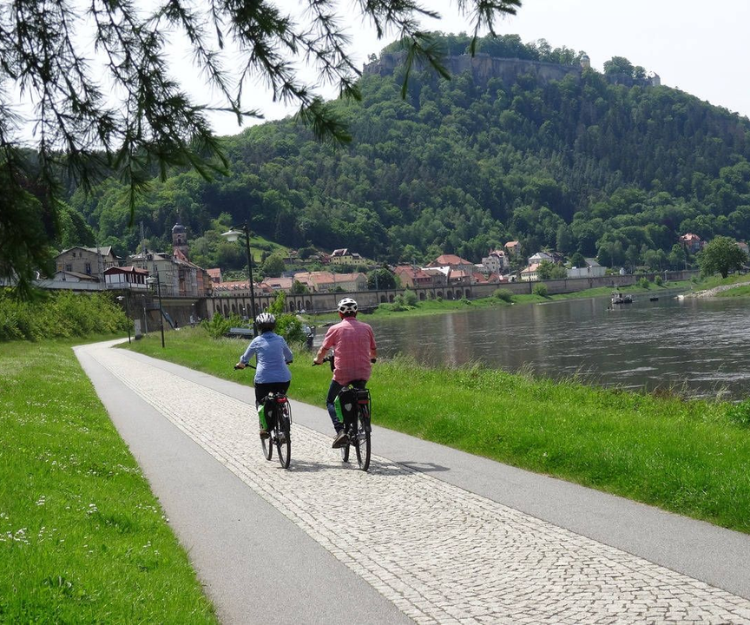
The Elbe Cycle Route (Elberadweg) in Lower Saxony is part of a longer cycling path that follows the Elbe River from its source in the Czech Republic to its mouth at the North Sea. In Lower Saxony, the route typically begins near the border with Saxony-Anhalt and continues northwards towards the coast.
Key towns and attractions along the Elbe Cycle Route in Lower Saxony include:
1. **Lauenburg**: A picturesque town with a well-preserved historic center located on the northern bank of the Elbe River.
2. **Bleckede**: Known for its Bleckede Castle and the Biosphere Reserve Elbtalaue, offering beautiful natural landscapes.
3. **Hitzacker**: A charming town with half-timbered houses and a medieval feel, situated in a scenic part of the Elbe valley.
4. **D├Âmitz**: Features D├Âmitz Fortress, a historic fortress overlooking the Elbe River.
5. **L├╝neburg**: Though technically in Lower Saxony, not directly on the Elbe, L├╝neburg is a notable town known for its well-preserved medieval architecture and salt mining history.
The route in Lower Saxony is well-marked and generally follows flat terrain along the river, making it suitable for cyclists of various skill levels. Cyclists can enjoy scenic views of the river, quaint villages, and historical landmarks along the way.

The Elbe Cycle Route (Elberadweg) as a long-distance cycling path along the Elbe River has been developed over several decades, with different sections and improvements made over time. The route has gained popularity since the late 20th century as efforts were made to create a continuous and well-marked cycling path from the source of the Elbe in the Czech Republic to its mouth at the North Sea.
While there isn't a specific year when the entire route "appeared," the development and promotion of the Elbe Cycle Route have been ongoing, with various sections in different regions being established and improved gradually over the years to cater to cyclists and promote tourism along the Elbe River.

The Elbe Cycle Route (Elberadweg) was not invented by a single person. Instead, it has been developed over time through collaborative efforts of various organizations, municipalities, and cycling enthusiasts along the Elbe River. The route's development involves planning, infrastructure improvements, and promotion by local governments, tourism agencies, and cycling associations in the regions through which it passes.
The concept of long-distance cycling routes like the Elbe Cycle Route typically emerges from a desire to promote cycling tourism, enhance infrastructure for cyclists, and highlight scenic and cultural attractions along the route. Therefore, the "invention" or development of such cycling routes is usually a collective effort involving multiple stakeholders over many years.

The Elbe Cycle Route (Elberadweg) is named after the Elbe River, which it closely follows for much of its route. "Elberadweg" translates to "Elbe River Cycle Path" or "Elbe River Cycle Route" in English. The name reflects the fact that the cycling path runs alongside the Elbe River, providing cyclists with a scenic journey through landscapes and towns along one of Central Europe's major rivers.
Naming cycling routes after rivers or geographical features they parallel is a common practice to clearly indicate the path's route and highlight the natural and cultural attractions associated with the area. In the case of the Elbe Cycle Route, cyclists can enjoy views of the Elbe River, visit historical towns along its banks, and experience the diverse landscapes that the river valley offers.




The Elbe Cycle Route (Elberadweg) is primarily known and designed for cycling rather than hiking. However, it can still appeal to hiking lovers for several reasons:
1. **Scenic Landscapes**: The route passes through picturesque landscapes along the Elbe River, offering beautiful views that can be enjoyed by hikers as well as cyclists.
2. **Accessibility**: Many sections of the route are well-maintained and relatively flat, making them suitable for leisurely walks or hikes, especially for those who prefer easy terrain.
3. **Historical and Cultural Sites**: The Elbe Cycle Route passes by historic towns, castles, and cultural landmarks, providing opportunities for hikers to explore these sites on foot.
4. **Nature and Wildlife**: The path often runs through natural reserves and protected areas, allowing hikers to appreciate the natural beauty and possibly encounter local wildlife.
While it's primarily designed for cyclists, hikers can certainly enjoy parts of the Elbe Cycle Route, especially for short walks or day hikes along scenic stretches. However, for longer hiking trails specifically tailored for hiking enthusiasts, there are other designated hiking routes and trails available in Germany and throughout Europe that may offer more extensive and varied hiking experiences.






The Elbe Cycle Route (Elberadweg) can be enjoyable for hiking throughout the year, depending on personal preferences and the specific section of the route you plan to explore:
1. **Spring and Summer**: These seasons are generally popular for hiking due to milder temperatures and longer daylight hours. The route is often lush and green during spring, with blooming flowers and budding trees adding to the scenery. Summer offers warmer weather, making it ideal for longer hikes and enjoying outdoor activities along the Elbe River.
2. **Autumn**: Fall brings stunning foliage colors, making it a picturesque time to hike along the Elbe Cycle Route. The weather is cooler but still pleasant, and the route may be less crowded compared to peak summer months.
3. **Winter**: While less common for hiking due to colder temperatures and potential snowfall, some sections of the Elbe Cycle Route can still be hiked in winter, especially on mild days. Winter hikes offer a different perspective, with serene landscapes and potential for enjoying cozy stops in cafes or historic towns along the way.
The Elbe Cycle Route offers flexibility for hiking enthusiasts throughout the year, with each season bringing its own unique charm and experiences. It's important to check weather conditions and trail accessibility, especially during winter months or after heavy rainfall, to ensure a safe and enjoyable hiking experience.